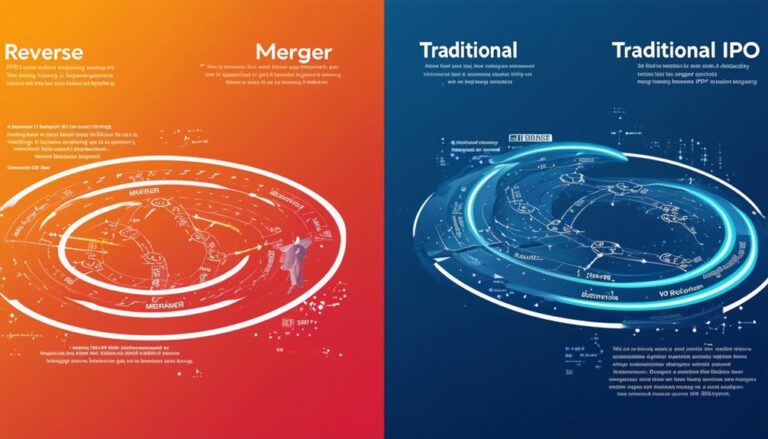The Role of Due Diligence in a Reverse Merger

Thorough due diligence plays a critical role in the reverse merger process. It allows us to carefully assess the target public company's financial stability, operational effectiveness, and legal compliance. It is crucial to scrutinize financial reports, operational protocols, and regulatory adherence to uncover potential risks, ensure a seamless transition, and make well-informed decisions.
Additionally, evaluating the expertise and credentials of the management team is vital. Their capability to steer growth and profitability directly impacts the success of the merged entity. By conducting comprehensive due diligence, we can negotiate advantageous merger terms and establish a solid foundation for a thriving and enduring future.
Further exploration into the specifics of this process can provide valuable insights.
Key Takeaways
Thorough due diligence plays a critical role in the success of a reverse merger by identifying potential risks, ensuring adherence to regulatory requirements, and enabling well-informed decision-making.
When conducting a reverse merger, it is essential to perform a comprehensive assessment of the target company's financial and operational status to ascertain its financial stability, long-term viability, and operational efficiency. This evaluation involves a detailed analysis of the company's financial statements, cash flow, and profitability ratios, providing valuable insights into its overall financial health.
In addition to financial scrutiny, evaluating the management team's experience, qualifications, and past performance is crucial in determining the feasibility and future prospects of the reverse merger. A competent and experienced management team can significantly impact the success of the merged entity.
Furthermore, ensuring compliance with securities regulations, addressing any potential conflicts of interest, and negotiating favorable terms for the merger are key components of a successful reverse merger. By meticulously examining these aspects through due diligence, companies can mitigate risks and increase the likelihood of a smooth and prosperous merger process.
Defining Reverse Mergers and Due Diligence
Reverse mergers are a method where a private company obtains a controlling interest in a public shell company. This allows the private company to go public without the traditional Initial Public Offering (IPO) process. While reverse mergers offer a quicker and less expensive way to become a publicly-traded company, they require thorough due diligence to ensure a successful transition.
In a reverse merger, it's crucial to conduct a comprehensive examination of the financial, legal, and operational aspects of the target public company. Assessing the management team, market position, and alignment of cultures is essential as these factors can significantly impact the future performance of the combined entity. By carefully scrutinizing the public company, potential risks can be identified, regulatory compliance ensured, and well-informed decisions made to support the overall goals of the reverse merger.
Although the speed and convenience of a reverse takeover make it an attractive option, the significance of diligent due diligence can't be emphasized enough. A rigorous investigation is essential to navigate the complexities of the process and establish a solid foundation for a seamless and prosperous transition to being a publicly-traded entity.
Assessing Financial and Operational Aspects
When analyzing the financial and operational aspects of the target company, we'll closely examine their financial statements and tax records to determine their overall financial well-being. Additionally, we'll assess their operational procedures, such as supply chain efficiency and production capabilities, to gauge their operational effectiveness. Moreover, we'll scrutinize their revenue sources, profit margins, and cost structures to gain insight into the financial sustainability of their business model.
In the context of mergers and acquisitions, a reverse merger is a type of transaction where a private company acquires a publicly traded company to bypass the lengthy and costly process of an initial public offering (IPO). This strategy allows the private company to go public by merging with an already listed company, thereby gaining access to public capital markets and regulatory compliance.
Reverse mergers have gained popularity as a quicker and more cost-effective way for private companies to become publicly traded. However, they also come with potential risks and regulatory challenges, as the process involves merging with an existing public entity, which may have its own financial and operational complexities.
Financial Statements Analysis
Analyzing a target company's financial statements is crucial when evaluating its overall financial health, profitability, and cash flow during the due diligence process of a reverse merger. Examining the operational aspects through these financial statements can provide valuable insights into the company's efficiency, growth potential, and risks.
By comparing historical financial data, we can identify trends, patterns, and inconsistencies in the target's performance over time.
Understanding key financial ratios and metrics, such as liquidity, leverage, and profitability, gives us a deeper understanding of the company's financial position. Additionally, scrutinizing the footnotes and disclosures in the financial statements can reveal essential information about the target's accounting policies, contingencies, and related party transactions – all critical factors in evaluating the overall risk profile.
This comprehensive analysis of the financial statements enables us to make informed decisions and identify potential opportunities or challenges that may arise during the reverse merger process, ensuring a successful transaction.
Operational Risks Identification
In addition to examining the financial statements, it's crucial to thoroughly evaluate the operational aspects of the target company when considering a reverse merger. This involves assessing the target's financial health, cash flow, and profitability ratios to gauge its overall stability.
Equally essential is conducting a detailed analysis of the target's production processes, supply chain management, and overall business operations to determine its operational efficiency.
Reverse mergers can present unique challenges compared to traditional mergers and acquisitions. These types of transactions allow a private company to go public by merging with a publicly traded shell company, bypassing the traditional initial public offering (IPO) process. While reverse mergers can offer a faster and potentially less expensive route to becoming a public company, they also carry inherent risks related to the target company's operational and financial health.
It is essential to conduct thorough due diligence on the target company's operational processes to identify any potential risks that may impact the success of the reverse merger. By closely examining the target's production capabilities, supply chain relationships, and overall business operations, acquirers can better understand the operational challenges and opportunities that may arise post-merger.
This proactive approach can help mitigate risks and ensure a smoother integration process in a reverse merger scenario.
Management Team Assessment
Assessing the management team is crucial in a successful reverse merger. We carefully evaluate the target company's leadership, examining their experience, qualifications, and track record in leading businesses effectively. Their ability to drive growth and profitability through strategic vision is key in determining the potential success of the merged entity.
In our comprehensive due diligence process, we scrutinize the management team for any potential issues or areas needing improvement. Simultaneously, we aim to uncover synergies that could improve operational efficiency and financial performance post-merger.
Understanding the strengths and weaknesses of the management team allows us to make well-informed decisions regarding the feasibility and prospects of the reverse merger.
Reviewing Legal and Regulatory Compliance

Examining the legal and regulatory compliance of the target company is vital for a successful reverse merger. It's important to delve into the details to uncover any potential risks and protect both parties involved.
Conducting a thorough legal and regulatory due diligence process involves meticulously scrutinizing all contracts, licenses, and permits to ensure full compliance with relevant laws and regulations. This step helps in identifying any outstanding regulatory issues or potential liabilities that could disrupt the integration process.
Additionally, confirming that the target company is in good standing and has met all necessary legal requirements is crucial for a smooth merger process.
Evaluating Intellectual Property and Contracts
When considering a reverse merger, it's essential to thoroughly examine the target company's intellectual property and contractual commitments. Understanding the value of the patents, trademarks, and copyrights held by the target can provide a significant competitive edge post-merger. It's crucial to assess any potential risks of infringement and review licensing agreements to ensure compliance with intellectual property laws.
Moreover, a comprehensive review of the target's contracts with suppliers, customers, and partners is necessary to uncover any constraints, liabilities, or obligations that could impact the success of the merger. By scrutinizing these contractual relationships, you can better understand the potential risks and benefits associated with the merger.
Identifying Potential Risks and Liabilities

When engaging in a reverse merger, it's crucial to meticulously examine the financial statements of the target company to uncover any discrepancies or undisclosed debts that could pose substantial risks post-merger.
Furthermore, assessing the target's adherence to regulatory requirements is vital in mitigating potential legal liabilities and fines.
Thorough due diligence allows for the identification and resolution of any hidden environmental liabilities or contractual obligations that may impact the success of the merged entity.
Financial Statement Review
When examining the financial statements of the target company in preparation for a reverse merger, it's crucial to carefully assess the balance sheet, income statement, and cash flow statement. These documents provide essential insights into the company's financial health and potential risks that could impact the success of the merger.
Analyzing the balance sheet allows us to evaluate the company's debt levels and determine whether they're sustainable or could pose a risk to its long-term solvency. By identifying any hidden liabilities or financial irregularities, we can address potential concerns before moving forward with the merger.
The income statement reveals fluctuations in the company's revenue, highlighting any concerning trends that may indicate instability. Understanding the company's revenue performance is crucial for assessing its overall financial viability and potential for growth post-merger.
Examining the cash flow statement is essential for uncovering any cash flow issues that could affect the company's ability to meet its financial obligations. By identifying and addressing these challenges early on, we can mitigate risks and ensure the smooth transition of the merger process.
Regulatory Compliance Risks
Ensuring compliance with securities regulations is crucial when engaging in a reverse merger, as any violations can result in legal consequences, substantial fines, and damage to reputations. It's essential to meticulously identify and address potential conflicts of interest during the due diligence process to prevent regulatory breaches and minimize legal risks.
Failing to disclose important information or misrepresenting facts can lead to expensive litigation and financial obligations after the merger. Therefore, maintaining detailed documentation of all assessments and findings is vital to showcase compliance with regulations and due diligence standards.
Incorporating legal experts specializing in securities regulations into the process can help navigate the intricate legal environment and effectively handle regulatory risks. By proactively tackling these compliance hurdles, we can increase the likelihood of a successful reverse merger that resonates with the innovative essence of our target audience.
Prioritizing regulatory compliance throughout the due diligence phase is a critical measure to ensure a seamless and legally sound transition for all parties involved.
Negotiating Favorable Merger Terms
When looking to negotiate advantageous merger terms, it's crucial to delve deep into the target company's financial records, obligations, and market standing to grasp its true value and potential synergies. This thorough examination of the target's contracts, agreements, and adherence to regulations is vital in uncovering any risks or undisclosed information that could impact the negotiation process positively.
To secure the most favorable deal, we should first analyze the target's financial statements and balance sheets to ascertain its actual value and identify any concealed liabilities.
By evaluating the target's position in the market, industry trends, and competitive landscape, we can better gauge potential synergies and opportunities for growth.
Additionally, scrutinizing the target's compliance with regulations will ensure that all necessary requirements have been met and help bring to light any potential compliance issues that could affect the negotiation outcomes.
Frequently Asked Questions
What Is the Due Diligence Process in a Merger?
We meticulously evaluate the financial health, management team, and legal compliance of the target company in a reverse merger. Additionally, we analyze market trends, review operational efficiency, and scrutinize intellectual property to make informed decisions that drive innovation.
In a reverse merger, a private company merges with a publicly traded company to go public without an initial public offering (IPO). This strategy allows the private company to become publicly traded by acquiring a controlling interest in the public company. Reverse mergers are often used as a faster and cheaper alternative to traditional IPOs, as they involve less regulatory scrutiny and paperwork.
By thoroughly assessing the target company's financials, management, and legal standing, we aim to ensure a smooth transition and successful integration post-merger. This comprehensive due diligence process is crucial in identifying any potential risks or issues that may impact the success of the reverse merger.
What Is the Purpose of Reverse Due Diligence?
Reverse due diligence in the context of a reverse merger involves thoroughly examining the acquiring company's qualifications, dissecting its business framework, scrutinizing the competitive environment, assessing the customer base, overseeing the data room, minimizing financial uncertainties, scrutinizing intellectual property rights, and appraising operational effectiveness to ensure strategic congruence.
In a reverse merger scenario, it is essential to delve into the acquiring company's background to understand its capabilities and potential for growth. By analyzing the business structure, one can determine how well it aligns with the objectives of the merger. Evaluating the competitive landscape helps in identifying potential threats and opportunities that may impact the success of the merger.
Reviewing the customer base of the acquiring company provides insights into its market reach and customer loyalty, which are crucial factors in determining the merger's potential for success. Managing the data room effectively ensures the secure exchange of information and promotes transparency throughout the merger process.
Mitigating financial risks through comprehensive due diligence is vital to safeguard the interests of all parties involved in the merger. Auditing intellectual property rights helps in protecting valuable assets and avoiding potential legal disputes in the future. Lastly, reviewing operational efficiency assists in identifying areas for improvement and optimization post-merger integration.
What Is the Role of Due Diligence in M&A?
We apply due diligence to shape our business strategy, evaluate transaction risks, ensure compliance, analyze financial performance, spot market opportunities, assess operational synergies, review intellectual property, optimize the supply chain, and evaluate employee culture. This comprehensive approach plays a crucial role in the success of our M&A integration process.
One type of merger that is gaining popularity in the business world is the reverse merger. In a reverse merger, a private company acquires a publicly traded company, allowing the private company to go public without an initial public offering (IPO). This strategy can provide a faster and potentially less expensive way for a private company to become publicly traded.
Reverse mergers can be advantageous for companies looking to access public markets quickly or for those seeking to enhance their liquidity. By bypassing the traditional IPO process, companies can save time and resources while still achieving their goal of going public. However, reverse mergers also come with their own set of risks and challenges, such as potential regulatory scrutiny and the need to carefully vet the public company being acquired.
What Are the Responsibilities of Due Diligence?
Our responsibilities include reviewing procedures, conducting thorough examinations, gathering detailed information, evaluating financials, checking legal compliance, analyzing operations, evaluating risks, researching markets, and investigating reputations. These tasks are crucial for making well-informed decisions and minimizing any unexpected issues that may arise after a reverse merger. In a reverse merger, a private company acquires a publicly traded company to bypass the lengthy and expensive process of going public through an initial public offering (IPO). This type of merger allows the private company to become publicly traded by merging with an already listed company. By following these steps diligently, we ensure that all aspects of the reverse merger are carefully evaluated and risks are mitigated effectively.
Conclusion
Thorough due diligence serves as the guiding light for reverse mergers, ensuring a safe journey to success. By meticulously analyzing the financial, operational, legal, and contractual aspects of the merger, we uncover any hidden obstacles that could jeopardize the deal.
With a clear view of the landscape, we can negotiate favorable terms and create a strategic path that minimizes risks and maximizes the potential for the merged entity to thrive. It's all about making informed decisions and navigating the merger process with confidence and clarity.





